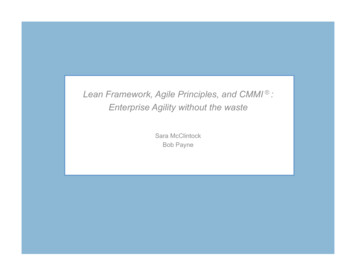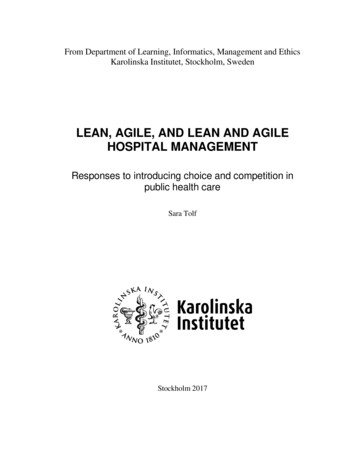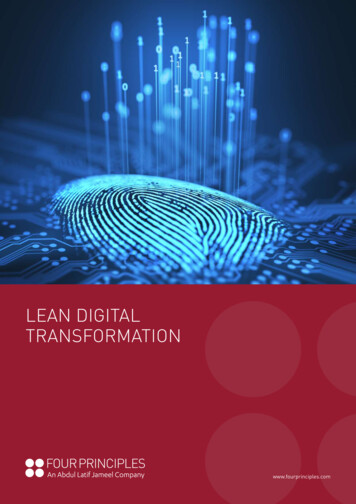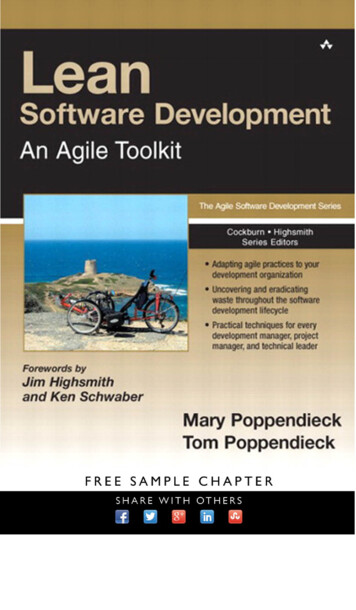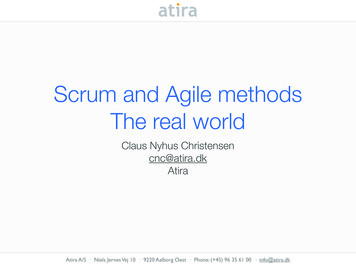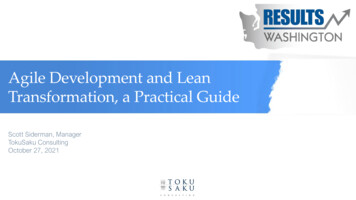
Transcription
Agile Development and LeanTransformation, a Practical GuideScott Siderman, ManagerTokuSaku ConsultingOctober 27, 2021
Agenda Why is Agile? Why is Lean? What is Lean Transformation?
A Few Quick Yes/No Questions I have been involved in a successful “Big Bang” project(System/Process change delivered all at once)? I have been involved with a successful Agile Development Project? I have been involved with a successful Lean project? I have been involved in a successful Lean Transformation project?
Why is Agile?
Initial Conditions Waterfall is prevailing– Phased nance– PMI Aligned– Believed to be overly regulated,planned, and micromanaged New methods being explored– Rapid Application Development– Unified Process– Dynamic Systems DevelopmentMethod– Scrum– Crystal Clear– Extreme Programming– Feature-driven development
Some Agile “Catalysts” Waterfall projects– Took a long time– Cost a lot of money Customers becoming moredemanding Technology becomingpervasive Need for more automation Need for more frequentenhancement to existingfunctionality New developer tools makemodular design anddevelopment easier
What is Agile? – The Manifesto Customer satisfaction by early andcontinuous delivery of valuablesoftware Welcome changing requirements, evenlate in development Deliver working software frequently(weeks rather than months) Close, daily cooperation betweenbusinesspeople and developers Projects are built around motivatedindividuals who should be trusted Face-to-face conversation is the bestfrom of communication Working software is the primary measure ofprogress Sustainable development, able to maintaina constant pace Continuous attention to technicalexcellence and good design Simplicity – the art of maximizing theamount of work not done – is essential Best architectures, requirements, anddesigns emerge from self-organizing teams Regularly,, the team reflects on how tobecome more effective, adjusts accordingly
Agile: Leaned Out Software Development Customer satisfaction by early andcontinuous delivery of valuable software Welcome changing requirements, even latein development Deliver working software frequently (weeksrather than months) Close, daily cooperation betweenbusinesspeople and developers Projects are built around motivatedindividuals who should be trusted Face-to-face conversation is the best fromof communication Working software is the primary measure ofprogress Sustainable development, able to maintaina constant pace Continuous attention to technicalexcellence and good design Simplicity – the art of maximizing theamount of work not done – is essential Best architectures, requirements, anddesigns emerge from self-organizing teams Regularly, the team reflects on how tobecome more effective, adjusts accordingly
What is Agile? – The Reality No holistic requirements– Epics– User Stories Short development sprints Preponderance ofmanagement tools/software Anecdotal evidence – agileimproves effectiveness– Software professionals– Teams– Organizations Empirical evidence - mixedand hard to find
DevOps – A Side Note A set of practices that combine Software Development and ITOperations Shares several aspects with Agile Development Complementary with Agile Development Aim is to shorten delivery time and provide continuous delivery ofhigh-quality software
Why is Lean?
Lean is A methodUses collaborative teamsImproves performanceSystematically eliminates wasteOften linked with Six Sigma (focuses on reducing variation)
The Eight Wastes DefectsOverproductionWaitingNon-utilized g
Practical Lean Concepts Focus on customer satisfaction andthe delivery of value Often focused on frequent,incremental improvements Close, daily improvementdiscussions between managers andworkers Projects are built around motivatedindividuals who should be trusted Face-to-face conversation is thebest from of communication Projects are focused on specific,more difficult to improve, issues Workshops are a typical solutionenvironment Continuous attention toperformance excellence andeffective metrics Regularly, the team reflects onhow to become more effective,adjusts accordingly
The Lean Virtuous CycleMeasure andassess processperformanceEnter hereIdentifyperformance gapDeterminecustomer needsand ssEvaluate resultsAdapted rom “Reengineering: the Implementation Perspective”, Hammer and Company, 1995Set vision andgoalLeanTransformation5%Replaceprocess
What is Lean Transformation?
Transforming Processes Using Lean Document current process Classify each action– Value Added– Business Value Added– Waste Organize Value Added actions Realign and add back selected Business Value Added actions Attempt to eliminate waste entirely
Current State
Value Added Analysis
Future State (Target)
Traditional Migration Approach Steps–––––––––Sketch solution designDevelop complete specificationsConduct ROI analysisFormulate implementation planObtain resourcesConstruct componentsIntegrate componentsTrain participantsInstall and cut over Characteristics– Replete with handoffs– Fragmented– Monolithic Performance– Slow– Unpredictable– Inflexible
A Release is The increment of implementationA subset of the end stateTypically implemented in less than 9 monthsHolisticA chunk of business value
Creating a Release – Identify Improvements How will we get from our current to future state? Identify all the changes needed to realize the new design Remember that the future state is a (moving) targetCurrentFuture
Creating a Release – Identify Improvements Lean efforts end with a cataloging of improvements Then, the differences show up– Improvement efforts create a time-ordered list– Transformations chunk all improvements into releases Side note: Quick Hits––––Easy and fast to implementProvide early value and winsConsistent with the future stateImplemented while developing and prior to the start of the formal plans
Creating Releases – Affinitize ImprovementsRelease 1Release 2Improvement 7Improvement 1Improvement 10Improvement 12Improvement 16Improvement 2Improvement 5Improvement 13Improvement 15Release 3Release 4Improvement 3Improvement 4Improvement 11Improvement 15Improvement 6Improvement 8Improvement 9
Migrating from Current to Future States:Release-based ImplementationRelease 2MagnitudeRelease 1 PilotPilotRelease 3PilotFunctionalityRelease NPilot
Magnitude “Dimensions” GeographyProduct lineMarket segmentCustomer segmentDistribution channelBusiness unitEmployee level
Why Releases? Speed– Deliver meaningful change morequickly– Produce results to “pay for”subsequent releases Learn in real time– Results of early releases advisesubsequent releases– React to outside changes asneeded Integrated, workable solutions– Demonstrate progress– Ease resistance to change Parallelism– Avoid sequential implementationof a long list of improvements– Requires good intrateamcommunication Pay it forward
Implementation Planning OptionsTypical Prioritized Fewest resources throughout Slowest to completeRace Start simultaneously Tapering resources Fastest to completeSemi-parallel Ordered by delivery of value Balancing of resources Faster
Inside a ReleaseLabPilotRollout Safe Test Fix Validate Limited Stakeholder Operation Fix Validate All Stakeholder Operation Measure impact Continuously improve
The Lab – “Hidden” Part of the Release A Lab precedes all pilots In the lab we– Create a simulation of real life– Experiment with detailed design Process Enabling Automation– Share progress withstakeholders in real time– Iterate until “done” Benefits include––––SafetyInsulation for failureLow-risk learningNot prematurely making largescale change Cost Exposure Need and/or inability to roll back
Questions?Scott Siderman, Manager(206) 364-0296scottsiderman@tokusaku.com
ReviewCharacteristicTraditionalAgileLeanLean TransformationOverall ScopeAutomationAutomationProcessProcess andEnabling ack-end loadedFrequent(?)FrequentQuickAmount of ValueLarge(?)UnclearSmallLargeCompletionOn ScheduleAs uousImprovementHolisticImprovement
Scott Siderman, Manager(206) 364-0296scottsiderman@tokusaku.com
Oct 27, 2021 · Agile Development and Lean Transformation, a Practical Guide Scott Siderman, Manager . User Stories Short development sprints Preponderance of management tools/software . A set of practices that combine Software Development and IT Operations Shares several aspects with Agile Development
